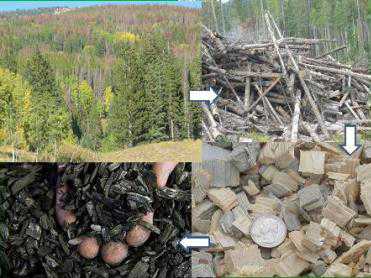Biochar is charcoal made from biomass (organic matter used for energy). A process called pyrolysis, in which biomass is heated to high temperature in the absence of oxygen, produces biochar along with combustible gases (syngas) and oils (bio-oils). Sources of biomass include algae, corn stover, grass, rice husks and straw, manure, municipal solid waste, and wood waste products, among others. Chemically, biochar consists mostly of carbon, along with some hydrogen, oxygen, nitrogen, phosphorus, and sulfur. The physical and chemical properties of biochar depend on the feedstock used and the pyrolysis conditions (temperature and time). In general, raising the pyrolysis temperature increases the aromatic carbon content of the biochar, a property that is believed to improve its resistance to microbial decomposition. See also: Aromatic hydrocarbon; Biomass; Carbon; Charcoal; Pyrolysis

Potential applications of biochar are as an energy source (biofuel), as an additive for soil amendment, and in waste management. Biochar and its combustible by-products represent a carbon-neutral energy source. However, pyrolysis would be an expensive means of producing energy from certain biomass sources, such as grass, straw, and wood, which can be combusted directly to produce bioenergy. See also: Biorefinery (wood)
At present, researchers are actively investigating the use of biochar as a soil amendment to improve soil quality and to sequester carbon. If biochar can be made resistant to breakdown in soil, it could be useful as a tool for locking up carbon dioxide and mitigating climate change. However, at present, it is not clear how long biochar can remain in soil before it decomposes and releases carbon dioxide to the atmosphere again. Further research is also needed to determine the best feedstocks and processing conditions to produce a biochar that is stable over time. See also: Organic geochemistry; Potential of soils for carbon sequestration; Soil
Perhaps the most immediate and promising application of biochar is in waste management. Farm manures, municipal solid waste, and wood waste are waste streams that could be converted to valuable energy products. Under the right pyrolysis conditions, the amount of bio-oil and syngas produced from them can be increased. To reduce the impact of forest fires in the western United States, the U.S. Forest Service has suggested using woody biomass from drought and insect-killed trees to produce bioenergy products through pyrolysis. In the state of California, for example, an estimated 66 million trees died during the drought of 2010 to 2016. Currently, there is little or no market for dead trees. See also: Forest fire; Sewage solids; Tree diseases





